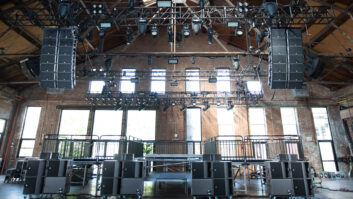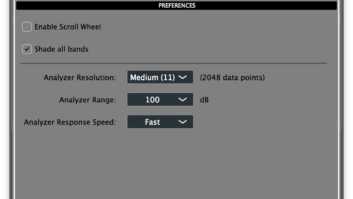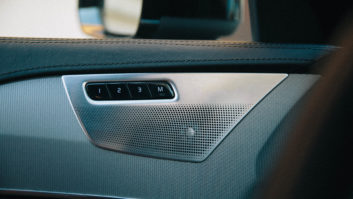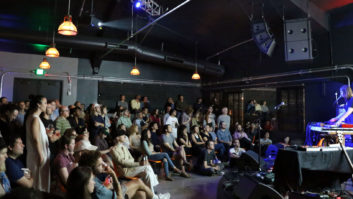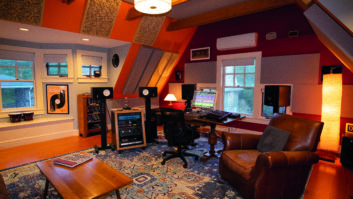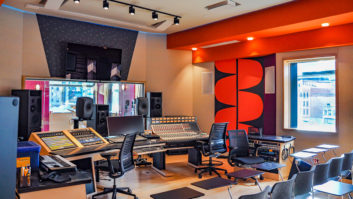There can often be a tension between architecture and acoustics in houses of worship, where visual considerations may take precedence over speech intelligibility or high sound pressure levels. Interestingly, art and science were combined by ancient Greek architects in order to harmonize construction and speech in their theaters; yet, more than twenty-one centuries later, acousticians and audio system designers may find themselves challenged by architectural considerations.
The ancient Greeks positioned tuned brass vases around their auditoria that resonated and, according to contemporary writings, increased the clarity and harmoniousness of the voice. “It was a true Helmholtz resonator that functioned like blowing across a bottle,” says Porter Falcon, an acoustician and president of Falcon Audio-Video, referring to the phenomenon first described in the modern era—in the 1850s—by German scientist Hermann von Helmholtz.
WELL-ROUNDED SOUND
The beam steering capabilities of two Renkus-Heinz ICONYX IC Live ICL-FR-DUAL columns, hung from the ceiling to avoid damaging the walls, cover the main floor and balcony, and eliminate the need for front fills at Shawnee’s First Baptist Church in Oklahoma. Ancient civilizations favored circular and semi-circular amphitheaters. “Acoustics 101 says do not use curved surfaces,” laughs Falcon, who has specialized in exactly those structures since 1983. That was the year he treated a cluster of five buildings for construction company Monolithic Dome.

The structures, built by inflating an air-form then layering it with cement, rebar, high-density foam and other materials, are cost-effective and environmentally friendly, and popular with some church organizations. The largest dome church, in Alabama, has a 280-foot diameter and seats 3,000.
“The volume is so great—what do you do with the bass?” says Falcon, who has worked on dozens of domed facilities worldwide. He has designed acoustic panels for the application that are built by his Falcon Audio Labs. The curved panels are built out of common materials, have a perforated face and are lined with rigid mineral wool. “They will absorb frequencies below 100 Hz, and the mids and highs are scattered back into the atmosphere,” he reports.
Because of the volume in these domes, Falcon, who also designs, builds and installs sound and lighting systems, has developed another method for improving the acoustics. “We build a lid. Sometimes I’ll produce a convoluted ceiling; we’ll tilt that ceiling. I do want some reflections off the ceiling, so we’ll use something like an Armstrong 505 tile, then one-inch rigid mineral wool on top of that.” The new Dallas Stadium apparently uses that same design. “They copied my idea, those rascals,” chuckles Falcon.
At the Living Word Bible Church in Mesa, AZ, a twin-dome structure, Falcon A/V retrofitted the sanctuary with an RCF speaker system. “They said, ‘We want stereo.’ I said there’s a science to it; there’s no stereo under certain conditions. But I was able to position those speakers and have them cross-fire and got a pretty good rendition of stereo in the middle of the church.”
LURKING LOWS
Hanging locations for the VUE Audiotechnik al-8 arrays were limited by the architectural features at World Agape Mission Church in Los Angeles, where VUE a-8w speakers provide coverage for the side seating area, which has a 9-foot ceiling. There is a bass monster lurking in every room, as discovered by another German scientist, Dr. Manfred Schroeder. In 1954, he identified the “cross-over frequency” (now known as the Schroeder frequency) below which—typically around 100 to 200 Hz—certain wavelengths resonate as discrete modes and above which mids and highs scatter and reverberate.

“From an acoustics perspective, the more you energize that room in the low end, the more you’re going to rob yourself of intelligibility,” observes Mike Hedden, chief steward in charge at Danley Sound Labs. “It’s much more difficult to get the vocals out in front, because now you’ve picked a fight with the big monster—he’s fully awake and ready to roar.”
The answer in such situations, says Hedden, is extreme vertical pattern control. “The listening plane as expressed is a tiny sliver of the entire volume of the room. So acoustically, just energize that one area, or the reverb side of Dr. Schroeder’s equation is going to raise its ugly head.”
Danley has developed a product for just such an application, the SBH or Skinny Big Horn. “It looks like a column but it’s not a column,” says Hedden. An SBH-10 covers 140 degrees on the horizontal plane—but just 10 degrees vertically. “The vertical’s so narrow, I can put it just at the top of the head of the first listener, so they’re in -6 dB or -10 dB.”
He continues, “We did a church, Peachtree Presbyterian, with a contractor in Atlanta. It’s a very large, cruciformshaped room with a couple of thousand seats. From the front of the chancel to the back wall of the main nave is in the neighborhood of 140 feet, and we did it with a left/right pair of SBHs. It’s got a fairly deep under-balcony area; the SBHs reach under there with such clarity that they shut all their ceiling speakers off.”
The solution is preferable to a distributed system, such as ceiling speakers, says Hedden. “It makes for a much more engaging worship experience. Your attention is drawn to the stage, as opposed to something right above you.” The SBH therefore also works in low-ceilinged converted warehouse or shopping-mall church applications.
VERTICALLY CHALLENGED
Low ceilings are certainly a challenge, Hedden says, although not due to reverberant energy. “An old friend of mine used to say, ‘If the ceiling’s under 20 feet, you have to go distributed.’ That’s predicated on the room depth; if it’s 50, 60 feet deep and the ceiling is down there at 10 to 15 feet, you start running into situations where the inverse square law is now your big bad enemy.”
One answer is one ceiling speaker per tile: “You can get extremely dense cone filters and lots of interaction, but at the end of the day, the intelligibility is going to be fairly good. The problem is that there’s such a detached feeling; there’s no sense of envelopment.” Danley’s Nano, and SHMini and SHMicro offer an alternative solution, he says, but they might be a hard sell compared to inexpensive ceiling units.
CHALLENGING EXPECTATIONS
St. Anthony of Padua Roman Catholic Church in New Bedford, MA, completed in 1912, installed two Danley SHB-10s, custom-painted to match the décor, to provide improved speech intelligibility in the church’s highly reverberant sanctuary. Renkus-Heinz tends to get involved in challenging acoustic spaces, according to Rik Kirby, VP sales and marketing. But, he comments, “The first thing we’ve got to uncover is what they’re trying to do. A church can now run the gamut from a pastor with a microphone through to a full-on rock concert. Even if it’s not their house band, they may have aspirations to invite the latest evangelical touring groups through their church.”

Kirby has seen expectations evolve over the past five years: Systems supporting contemporary music are now in greater demand. Happily, he says, Renkus- Heinz offers high SPL solutions with precise pattern control—the company is well-known for its beam-steerable products—to keep that beast at bay. “We’re able to place the sound just on the people and to avoid the architectural features, be they historic features, as they might be in a large stone cathedral, or more modern features where it’s the art and the style of the room that’s going to get impacted.”
In the past, he continues, “The traditional solution was to put a lot of big loudspeakers at one end and then as you get further into the room with the reverb and the reflections and the acoustic soup that happens, when you reach the point where they can’t understand anymore, stick another loudspeaker in to improve intelligibility there. We’ve solved that by sticking with loudspeakers at one end of the room, but making sure the sound doesn’t touch the room so we don’t have that reverberation to start with. Where it’s developed for us over the last seven years is that we’ve introduced higher power, larger drivers, bigger amplifier versions that allow us to take that up to full concert levels.”
While the equipment cost might be higher for installing a steerable rather than a distributed solution, he points out, the actual finished project cost very often works out to be cheaper. “You’re only installing a couple of loudspeakers at one end of the room. You might buy a ceiling speaker for $98 or whatever they run these days, but the cost of installation is now very significant compared to the cost of the product that’s being installed.”
FRONT-TO-BACK FIDELITY
A sound system renovation at World Agape Mission Church in Los Angeles further demonstrates some of the acoustical challenges facing integrators and manufacturers, and highlights that tension between art and science.
The senior pastor, a former professional audio engineer, wanted everyone in the congregation to have great sound, reports Michael Yoo, president of Genesis Technology, the Washington, DC-based systems integrator. Yet, because of a special, oval-shaped ceiling design and other interior architectural features, Yoo was limited in his options for positioning the VUE Audiotechnik speakers that he recommended for the project.
The church would not allow anything to be installed on a proscenium behind the altar, but also, explains Yoo, “Because of the unique ceiling design, we couldn’t hang heavy speakers.” Further, because the church wanted to show off the beautiful ceiling design, there was no possibility of flying delay speakers. Thankfully, he says, “VUE’s al-8 arrays gave us light weight yet full sound and even coverage.”
There was another challenge: “As you go further back, the floor inclines and thus the ceiling is only nine feet at the back seats. We chose the VUE a-8w for the delay side back seats—it really matches the sound characteristics of the al-8.”
The church had something of a unique additional challenge. Located in a very densely populated area, neighboring apartments are only feet away. From his experience with previous systems, says Yoo, “When you push the sound to get evenly loud, you get one very hot spot and it causes complaints from the neighbors. This VUE system has such a tight control; we tuned the system with the windows open—because the air conditioning system was not completed that time—and the neighbors didn’t mind.”
Yoo reports, “The system sounds crystal clear; the vocal just pops out. And the surprising thing is, it sounds even better at higher SPLs.”
